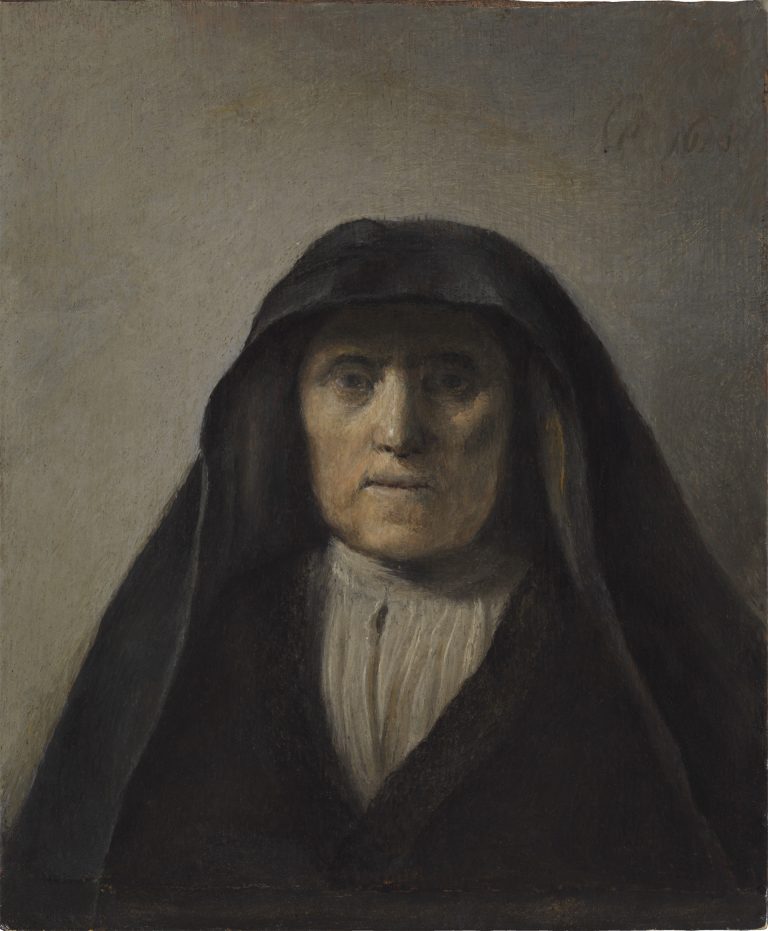This haunting image of an old woman wearing a black, hooded garment that drapes over her shoulders is remarkably similar in appearance to an etching Rembrandt van Rijn (1606–69) made in 1628 of an aged woman with profoundly wrinkled skin wearing a similar hooded cape that likewise casts a shadow over her eyes (fig 1). In both the etching and the painting the woman stares directly out at the viewer in a manner that emphasizes her deep-set eyes and the straight lines of her nose and mouth. Rembrandt’s model traditionally has been identified as his mother. This identification going back to the 1679 inventory of the Amsterdam print and map dealer Clement de Jonghe (1624/5–77), in which an etching of this elderly woman, dated 1631, is listed as “Rembrandt’s Mother.”1 This same woman appears in a number of other prints, drawings and paintings by Rembrandt and other artists associated with him in Leiden during the late 1620s and early 1630s.
It is highly likely that the identification of the model in this etching as Rembrandt’s mother is correct. Not only did Clement de Jonghe know the artist personally, but he was also a passionate collector of Rembrandt’s etchings and would have known much about them. Rembrandt’s mother, Neeltgen Willemsdr, was born around 1568, which means that she would have been about 60 years old in the late 1620s, an appropriate age for the sitter in these images. Nevertheless, despite the close similarities between Rembrandt’s etching of 1628 and the Leiden Collection painting, it is not certain that the same individual is depicted in both works. In the painting the woman has a more elongated face, more pronounced cheek bones, and a stronger jaw line than those of “Rembrandt’s mother.”
Despite these physiological differences, the compositional similarities between Rembrandt’s etching of 1628 and this painting helped persuade earlier scholars that this head study was an autograph painting by Rembrandt. Strengthening that argument is the fact that these scholars mistakenly read the monogram on the painting as an R. However, in various publications from 1933 to 1966, Kurt Bauch cast doubt on that attribution, proposing instead that this work was painted by Jan Lievens (1607–74) and retouched by Rembrandt.2 Subsequently, Horst Gerson omitted the painting from his 1969 Rembrandt monograph. In 1982, the Rembrandt Research Project declared it a nineteenth-century imitation of Rembrandt.3 This assessment, however, is surely wrong, as subsequent dendrochronological analysis has determined that the panel was available in the 1630s. The thin, translucent handling of paint, moreover, is characteristic of Leiden paintings from the early 1630s. Who painted this work, however, is a question that is difficult to answer. Despite the close stylistic and thematic connections to Rembrandt and his workshop, the brushwork differs from that of any of the known artists working in Leiden around 1630, including Rembrandt, Lievens, and Gerrit Dou (1613–75).
The artist who executed this work changed the woman’s expression during the painting process. An X-radiograph reveals that he originally portrayed the woman with parted lips, as though she was in the act of speaking, and modeled both eyes with lead white paint, indicating that they were not originally meant to be cast in shadow (fig 2).4 Why these changes were made is not known, but the result is that the woman’s expression is more solemn and severe than originally conceived. Her black hooded cloak relates closely to those worn by Roman Catholic lay sisters, known as klopjes.5
Instead of being an R the monogram appears to be a lowercase P inscribed inside a larger C (fig 3).6 This monogram links the work to an enigmatic painting in the Palais des Beaux-Arts in Lille, Student Smoking a Pipe (fig 4), which has a similar inscription: a large P inscribed in a C. That painting has long been attributed to Pieter Codde (1599–1678), mainly on this basis. But the astonishing aesthetic performance of this work—in composition, color, light, description, and evocation of emotion—outstrips even the finest examples of the respectably talented Amsterdam genre painter. Furthermore, Codde’s typical monogram, with the C continuing the loop of the P then proceeding back and downward, differs markedly from that appearing in the Lille painting, and his authorship of that work is no longer accepted.7
The similarity of the monogram in the Leiden Collection painting appears to provide strong evidence of a common but as of yet unidentified artist. Nevertheless, caution about making that association is still necessary because the appearance of these two paintings is so different.8 The Lille painting exhibits breathtaking coloristic sophistication, with controlled contrasts of cool and warm hues, quite different from the overall grayish cast of the Leiden Collection painting. The pulsating rhythms in the Lille painting, generated by bulky fabric forms and striking curved and angular contours, find no parallel in the stark image of Bust of an Old Woman, which depends more closely on Rembrandt’s models. The possibility of a workshop connection between the Lille and Leiden Collection paintings—of master and pupil for instance—might explain the shared monogram, but such a hypothesis remains purely speculative.
